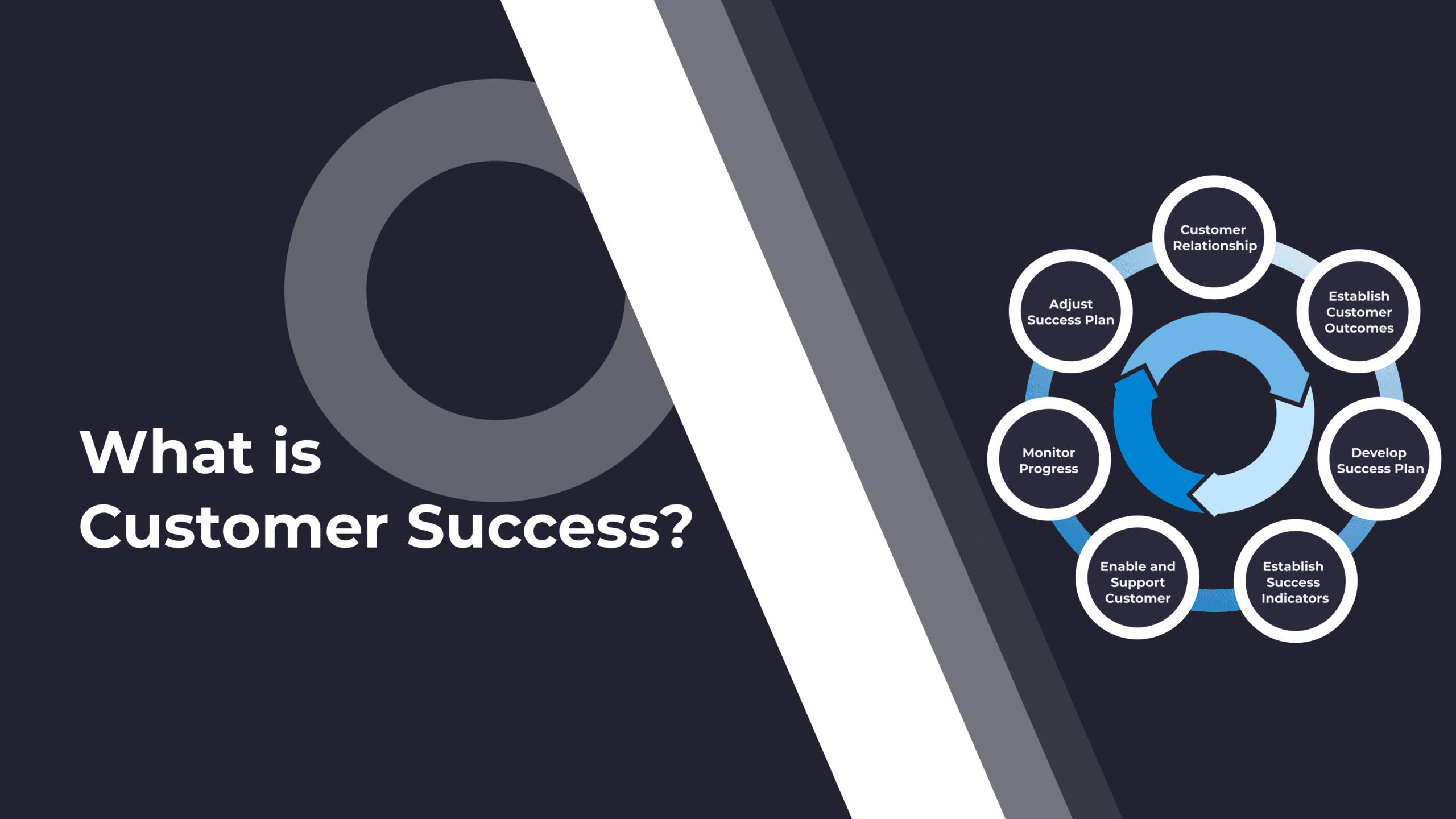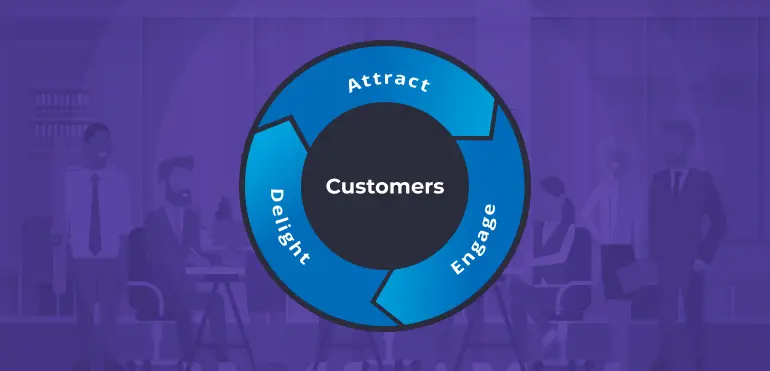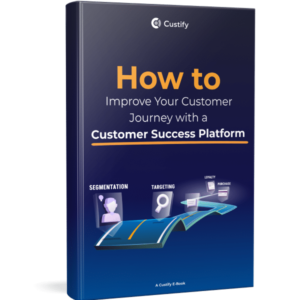If you’ve ever been at a loss when deciding how many accounts to assign per CSM or vice-versa, then we’ve got the answer.
Today, our mission is simple: figure out the best CSM ratio for you.
We’re going to look at:
- The definition of the CSM ratio and all the minute implications around it
- The four main CSM distribution models, as well as extensive details on how to use each.
- Then we’ll end with a comparison table, allowing you to review every possible course of action and pick a ratio that feels right to your use case.
What Is the CSM Ratio?
Your CSM ratio (aka CSM-to-account or CSMs-per-customer ratio) is simply that – the ratio of CSMs / accounts. Most businesses opt for a one-to-many ratio, often abridged as 1:many, but we’ve seen various strategies based on business type, niche, product complexity, customer needs, and other company-specific factors.
What’s more, going for 1:many by default is often a mistake, as many CS and business leaders soon discover that:
- Customers sometimes need more help than one person can provide, often from people with more diverse skill sets and functions.
- It’s not conducive to serving customer needs and outcomes to have a single CSM assigned to one account permanently – flexibility allows for better customer success overall.
- Adding more CSMs can often be worth it simply for how it makes the customer feel to have a team on hand to help, driving loyalty and evolving the relationship.
Moving forward, let’s review all four types of CSM-to-account ratios:
CSM Distribution Strategies
1. One to One Model
The one-to-one, or 1:1 model is highly personalized, customer-focused, and typically paired with high-touch customer engagement models, whereby the account often needs significant aid during implementation, while the users themselves also often need help within the product. The lead CSM for that account will be able to pool resources and deliver customer care while working towards their goals and outcomes in a relationship that in and of itself is a value addition.
Pros / Cons of One to One CSM Ratio
| PROs | CONs |
| Customer relationship as a value addition | Costly, COGS can far overtake CLTV |
| Deep understanding of customer goals | Can spiral into many:1 due to customer requests |
| Promotes long term loyalty | Lead CSM fully booked for a single client |
| Optimized customer onboarding | For enterprise clients, 1 CSM may not be enough |
| Increased product engagement and adoption | Time allocation can be unpredictable |
When to Pick a 1:1 CSM Ratio
The one to one CSM ratio is great when:
- You have Enterprise clients that need constant care and attention
- A single customer churning could hinder your business’ ability to remain solvent
- Your clients require you to understand their strategy, company, industry, & more
- You have significant opportunities to upsell your clients and generate expansion revenue
- Your time to value is high and customers need reassurance during value realization
- Your client relationships tend to blossom into business partnerships
- You follow a high touch customer engagement model
Note: you may need more than just one of the above to be true in order for a 1:1 ratio to be profitable.
How to Implement a One to One Model
In terms of actual implementation, a one-to-one model is likely the least complex to put together all you need is to:
- Set up a functional customer success dashboard where the lead CSM can monitor the account, set up health scores, automation flows, and generally have an overview of tasks, customer interactions, account information, and anything else they require.
- Develop a method of assigning clients to CSMs based on various factors that make sense for your organization. These could be: product knowledge, social skills and emotional intelligence, industry knowledge, customer success experience, CSM performance, etc.
- Plan a way of allocating extra resources so the lead CSM doesn’t feel unable to fulfill more complex customer requests. They must have the necessary tools and other people ready to provide assistance on request, as well as the confidence to know they can go to them for help.
Tools You Need for a One to One Model
The set of tools necessary for a successful 1:1 model implementation includes:
- A good customer success platform (CSP)
- A good note-taking app with AI and meeting notes capabilities
- A good customer support solution that facilitates customer communications
- A video conferencing software with the ability to record meetings longer than 1 hour
- A good data collection, CX, and customer survey app with social listening capabilities
- A functional CRM
- A good email client that can integrate with your CSP
2. One to Many Model
The classic CSM ratio we see everywhere these days is one to many, or 1:many. It’s exactly what it sounds like – one CSM handles more and more accounts. The exact number of accounts per CSM will greatly depend on the business strategy, type of product, and engagement model necessary to service the customer base. The one-to-many approach is also the most scalable and makes the most use of customer success software.
Pros / Cons of One to Many CSM Ratio
| PROs | CONs |
| Highly effective use of available resources | Limits the amount of help a CSM can provide |
| Adaptable and scalable based your needs | Can be ineffective for complex products |
| Can service hundreds / thousands of accounts | May not adequately service high-ARR accounts |
| Enables scripts & playbooks for common issues | Can lead to CSM burnout & quiet quitting |
| Allows tiered distribution by engagement model | Tends to prioritize quantitative metrics / tactics |
Types of One to Many Models and When to Pick 1:many
- 1:<10. One of the best methods of implementing a 1:many approach, so long as you don’t have a low-touch model or thousands of accounts.
Ideal for: high touch customers with >$100,000 ACV - 1:10-25. A more scalable approach, conducive for handling mid touch accounts.
Ideal for: mid-to-high touch customers, $50K-$100K ACV - 1:25-50. Starting to get into the mid to low touch area. Safe if you can automate multiple recurring tasks per customer.
Ideal for: low-to-mid touch customers, or tech touch customers, $25K-50K ACV - 1:50-100: Great for low touch software, can easily become ineffective and lead to burnout if customers frequently need extra assistance.
Ideal for: low touch customers, $10K-25K ACV - 1:100+: Ideal for simple products that don’t require customer engagement and can follow automated flows.
Ideal for: low touch customers <$10K
How to Implement a One to Many Model
For implementation, a one-to-many model is possibly the most difficult to implement, but a good CSP like Custify can significantly lower the complexity of the setup process. You’ll need to:
- Optimize your customer success platform. To adequately service tens or hundreds of accounts per CSM, you need a proper setup for your CSP. This means: integrations, reports, health scores, automation flows, and everything in between.
- Determine the most effective CSM split. By account type / engagement model / ARR / anything else that makes sense for your customer base / product / business model.
- Create playbooks for common issues. Prevent customer churn at scale by implementing automated playbooks that trigger whenever typical churn precursors are recorded by your CSP. This is another reason why you need an optimized CSP if you’re going for 1:many.
- Determine how you handle crises. What happens if multiple customers unexpectedly churn in a single week? What about if a customer is having product issues and starts complaining everywhere they can around the internet? You must first be able to detect all that, and secondly have some emergency plans in place for when you need to step in manually.
- Create a plan for highly-complex scenarios and accounts. Sometimes an account might enter a new level of complexity that’s unique for them. At that point, you should know if you need to assign more people from other teams and / or extra CSMs to help.
Tools You Need for a One to Many Model
The set of tools necessary for a successful 1:many model implementation includes:
- A good customer success platform (CSP) with great collaboration features
- A good note-taking app with AI, collaboration, and meeting notes capabilities
- A good customer support solution that facilitates customer communications
- A good data collection, CX, and customer survey app with social listening capabilities
- A functional CRM
- A good email client that can integrate with your CSP
3. Many to One Model
In the business world, there are Enterprise clients and then there are Enterprise clients. By that, I mean some big clients require far more attention than others. In fact, they may need a level of attention that only the many to one approach can offer:
The many-to-one model ensures customers get an entire team of CSMs with diverse skills to help with their needs. This could be anything from implementation to product setup, tracking goals, teaching their entire enterprise to use the new software, migration services when it comes to switching providers, and so on. Customers of this sort will be ready to put down a lot of money just so you can help them set everything up and then have a team on hand just for them. In that case, it simply makes business sense to not limit yourself to a 1:1 approach and move more CSMs to that account, lest all that money remains on the table.
Pros / Cons of Many to One CSM Ratio
| PROs | CONs |
| Can help secure large Enterprise contracts | High danger of compounding costs |
| Diverse team tailored to help customers | Blocks a significant pool of company resources |
| Enables alignment and collaboration on strategy | Risk of depending on a single customer |
| Great for crisis response and mitigation | Risk of poor communication & coordination |
| Optimizes entire customer journey | Potential inconsistency due to too many CSMs |
When to Pick a many:1 CSM Ratio
The many to one CSM ratio works well when:
- You have big Enterprise clients with complex initial and ongoing requirements
- The client requires significant migration efforts to implement your solution
- The client requires a CSM team on hand to prevent issues spilling over to their customers
- The client or your product require extensive training sessions to maximize value
- Your clients require you to understand and assist in their strategy, goals, management
- You want to turn the customer relationship into a business partnership
How to Implement a Many to One Model
In terms of actual implementation, a many-to-one model requires a bit of work during the initial stages:
- Set up an optimized and fully integrated customer success platform where the CSM team can monitor and collaborate on the account, set up health scores, automation flows, and generally have an overview of tasks, customer interactions, account information, and anything else they require.
- Develop strong customer success teams for each client – you’ll need to come up with a selection and testing process, as well as a way to replace team members in case the unforeseen happens and you need to. Furthermore, teams of this kind need a leader and assigned functions for each member.
- Plan a way of managing resources – for such a large client, it might make sense to have a big team during migration, implementation, and onboarding. However, you may not need that many CSMs later on. Or you may need even more – depending on what the client plans to do. You should therefore be ready to reassign people, budgets, and tools to help clients in the best way possible.
Tools You Need for a Many to One Model
The set of tools necessary for a successful many:1 model implementation includes:
- A good customer success platform (CSP) with advanced features like calculated metrics
- A good note-taking app with AI, collaboration, and meeting notes capabilities
- A good customer support solution that enables live, omnichannel customer communications
- A video conferencing software with the ability to record meetings longer than 1 hour
- A good data collection, CX, and customer survey app with social listening capabilities
- A good and fully integrated CRM
- A good email client that can integrate with your CSP and CRM
4. Many to Many Model
Last but far from least, we’ve got the many to many approach. Often this one is evolved from an entirely disorganized CSM distribution. A large number of CSMs manage a large number of customers, without a specific lead per account. Instead, everyone works together in an effort to provide a consistent level of service across the board as well as be able to act and resolve issues with increased speed and efficiency.
Pros / Cons of Many to Many CSM Ratio
| PROs | CONs |
| Highly adaptable CSM team able to reprioritize | Risk of becoming highly disorganized |
| Best overall for scalability | Difficulty providing a consistent level of service |
| Can be mixed with customer support | Lack of personalized touch |
| Diverse team can be tailored to help customers | Challenging to maintain quality level |
| If built well, can service entire customer base | Data hygiene and governance challenges |
When to Pick a many:many CSM Ratio
The many to many CSM ratio is particularly useful for when:
- You have thousands of low touch clients
- You can safely set up automated playbooks to handle most, if not all of your customers
- Your customer base or product type demand flexibility in the number of CSMs per account
- Your customers are in the <$10K category and it doesn’t make sense to assign more than 100 accounts per CSM
- You have a simple product that customers easily understand
- You can provide value additions at scale through tutorials, videos, product tours, documentation articles, without needing to interact one on one
- Even your highest pricing option is still low touch, requiring minimal interactions with clients
How to Implement a Many to Many Model
When it comes to implementation, many-to-many requires a bit of setup in terms of data governance – i.e. making sure you’re collecting all relevant data points from your entire customer base and centralizing those in a single platform for all CSMs. To do this:
- Optimize and fully-integrate your customer success platform. To adequately service hundreds or thousands of accounts with all CSMs having complete visibility, you’ll need a high-performing CSP with top-level dashboards. This includes: integrations, reporting, health scores, automation flows, and everything in between, ready and available to be set up all your existing accounts and at scale.
- Create playbooks for common issues. Prevent customer churn at scale by implementing automated playbooks that trigger whenever typical churn precursors are recorded by your CSP. This is another reason why you need an optimized CSP if you’re going for many:many.
- Determine how you handle crises. What happens if multiple customers unexpectedly churn in a single week? Or if a customer is having product issues. Or if you start receiving negative reviews and / or comments. Detection should be your first priority, after which you should have scripts in place to deal with the most common customer complaints.
- Create a customer communication strategy. Since you don’t have a single person in charge of specific accounts, you’ll need to have a communication strategy for your entire customer base – determine how you communicate updates, tutorials, new features, and so on.
Tools You Need for a Many to One Model
The set of tools necessary for a successful 1:many model implementation includes:
- A good customer success platform (CSP) with great collaboration features
- A good note-taking app
- A good customer support solution that facilitates customer communications and supports all text channels (low touch customers should be able to reach out via chat if they have issues)
- A good data collection, CX, and customer survey app with social listening capabilities
- A functional CRM
- A good email client that can integrate with your CSP

Comparing One-to-One vs One-to-Many vs Many-to-One vs Many-to-Many Models
| Model | One-to-One | One-to-Many | Many-to-One | Many-to-Many |
| Description | One CSM services, supports, and oversees one Customer Account. | One CSM supports many Customer Accounts, with advanced tools for scaling and automation. | Many CSMs or specialists collaborate to support one Customer Account. | Many CSMs support many or sometimes all Customer Accounts. |
| Best for | High-touch, Medium-high ACV Enterprise accounts requiring personalized attention. | Low-touch or Tech-touch accounts that require less personalized attention, scalable. | Very high-touch, High & Very High-ACV Enterprise accounts with complex needs like full migration, training, etc. | Very low-touch, for SaaS companies with a broad customer base that can easily use the product. |
| Advantages | 1. Customer relationship as a value addition | 1. Highly effective use of available resources | 1. Can help secure large Enterprise contracts | 1. Highly adaptable CSM team able to reprioritize |
| 2. Deep understanding of customer goals | 2. Adaptable and scalable based your needs | 2. Diverse team tailored to help customers | 2. Best overall for scalability | |
| 3. Promotes long term loyalty | 3. Can service hundreds / thousands of accounts | 3. Enables alignment and collaboration on strategy | 3. Can be mixed with customer support | |
| 4. Optimized customer onboarding | 4. Enables scripts & playbooks for common issues | 4. Great for crisis response and mitigation | 4. Diverse team can be tailored to help customers | |
| 5. Increased product engagement and adoption | 5. Allows tiered distribution by engagement model | 5. Optimizes entire customer journey | 5. If built well, can service entire customer base | |
| Challenges | 1. Costly, COGS can far overtake CLTV | 1. Limits the amount of help a CSM can provide | 1. High danger of compounding costs | 1. Risk of becoming highly disorganized |
| 2. Can spiral into many:1 due to customer requests | 2. Can be ineffective for complex products | 2. Blocks a significant pool of company resources | 2. Difficulty providing a consistent level of service | |
| 3. Lead CSM fully booked for a single client | 3. May not adequately service high-ARR accounts | 3. Risk of depending on a single customer | 3. Lack of personalized touch | |
| 4. For enterprise clients, 1 CSM may not be enough | 4. Can lead to CSM burnout & quiet quitting | 4. Risk of poor communication & coordination | 4. Challenging to maintain quality level | |
| 5. Time allocation can be unpredictable | 5. Tends to prioritize quantitative metrics / tactics | 5. Potential inconsistency due to too many CSMs | 5. Data hygiene and governance challenges |
At Custify we don’t believe in simply following the 1:many approach that most industry leaders default to. In many cases, customers have more complex needs and you have a choice: get more CSMs involved or ignore / dismiss their needs. Naturally, we always choose the first option as we try to prioritize our customers above all else.
Of course, through our many collaboration tools and efficient dashboards in the Custify platform, the amount of work a CSM has to complete per account is drastically reduced. This allows you to scale customer success and maximize the number of accounts you can service. We also believe in giving you the freedom work with whatever CSM ratio you need, because we know from experience:
- Even with a kickass customer success platform like Custify, which we also use, you can and often do have particularly complex, high ARR, or high-touch accounts that warrant a 1:1 or many:1 approach.
- You may need a lead CSM to conduct the CSM orchestra, so we’ve made it easy to use our platform to assign tasks and ensure visibility for everyone on your team.
- A mixed approach such as this is conducive to servicing customers at critical points in their customer journey. For example: a customer might typically only need one CSM, but during a particularly difficult point in implementation, they need more help. A few clicks and Slack messages later, and that account can have 5 CSMs brainstorming how to help them in a call.
- The best CSM ratio is the one you determine to be necessary for each account. This approach may not be ideal for bootstrapped companies, but it is the right one, and one we can all strive to achieve.

FAQs about CSM Ratios
1. What is a CSM ratio, and why does it matter?
Picture this: each of our Customer Success Managers is like a superhero. The CSM ratio? It’s the number of people (or accounts) they’re saving each day. Get this ratio right, and you’re looking at happy customers and a team that’s firing on all cylinders. It’s like finding the perfect beat for a dance – too fast, and you’re tripping over your feet; too slow, and you’re not winning any dance-offs.
2. How do I nail the perfect CSM ratio for my business?
Imagine you’re a chef. Your business model is your kitchen, your product is the dish, and your customers are your diners. You wouldn’t serve a steak the same way you’d serve sushi, right? Assess your ingredients (customer needs), check your tools (CSM workload), and decide on the dish you want to create (desired outcomes). Aim for a Michelin star service that doesn’t leave your kitchen in chaos.
3. Can the CSM ratio affect customer satisfaction?
Oh, absolutely! Picture this: when your CSM squad is as jam-packed as a subway car during rush hour, customers start feeling like they’re getting the cold shoulder. That’s when the grumbles kick in. But, if you’ve got CSMs lounging around because they’ve got too few customers to tend to, it’s kinda like throwing a party where only two people show up. Super awkward, right? Nailing that just-right number means everyone’s getting the attention they deserve without anyone feeling left out or smothered.
4. What are the benefits of a one-to-many CSM ratio?
Here’s the skinny: going one-to-many is like unlocking a secret level in a video game where you can clone your CSMs. It’s brilliant for when you’ve got a galaxy of customers orbiting around, most of whom just need a quick check-in rather than a deep dive. It’s about equipping your team with some snazzy gadgets (think tech tools and platforms) that let them sprinkle their magic over a broader audience, ensuring no one’s left hanging and everyone feels like they’re part of the in-crowd.
5. When should I consider a one-to-one CSM ratio?
Lean in for this one: it’s when you’ve got those customers who are all about the VIP experience. They don’t just want the standard fare; they’re after the deluxe edition, custom-fitted just for them. Losing one of these big fish could send ripples across your pond, so you want to make sure they’re feeling more than just satisfied—they should feel like rock stars.
Assigning them their very own CSM is like giving them a backstage pass to your business, ensuring they get the exclusivity and attention that keeps them raving fans.
6. How can technology help manage different CSM ratios?
Let’s get techy. Imagine you’ve got a toolkit that turns your team into customer success ninjas—swoosh, problem solved; swoosh, another happy customer. A solid Customer Success Platform is like having a magic wand. It sorts the mundane stuff, digs up gold nuggets of customer insights, and personalizes the heck out of customer interactions. This way, your team can manage more folks without dropping the ball or losing that personal touch.
7. What challenges might arise from a many-to-one CSM ratio?
Ah, the many-to-one conundrum. It’s like putting all your eggs in one basket, then realizing that basket’s got a hole. Sure, focusing a bunch of CSMs on a handful of big-shot clients can feel all VIP and exclusive. But if one of those big fish decides to swim away, you’re left with a ton of resources on standby. The trick? Killer coordination and a game plan that’s as tight as a drum to keep those big players playing in your yard.
8. Is the many-to-many CSM ratio suitable for all types of businesses?
Not exactly a one-size-fits-all, but think of it as your utility player—versatile, reliable, and ready to adapt. It’s perfect for businesses that have a wide spread of customers who can pretty much serve themselves with a little nudge here and there. Imagine running a self-service kiosk; customers do their thing while you’re there to help if someone presses the “help” button. It’s about empowering customers while keeping your team free to tackle the big stuff.
9. How often should I review and adjust my CSM ratio?
Treat it like your favorite houseplant; it needs regular check-ups to thrive. The business world’s always spinning—new features here, shifting customer needs there. These changes mean it’s time to prune or water your CSM strategy. A look-see every quarter or so keeps things fresh and ensures your customers and team are in a happy place.
What’s Your CSM Ratio?
If you’ve made it this far – congrats – you now have a great overview of all the typical CSM-to-account ratios. To sum up:
- For high touch accounts, you can pick 1:1 or many:1, or specific subtypes of 1:many
- For tech touch or mid touch, it’s safe to go for 1:many and decide on subdivisions based on your particular use case.
- For low touch, it’s best to go for 1:many or many:many, depending on how many customers you have overall and what you can do to facilitate customer care at scale.
Now that you know all about these ratios, it’s time to proceed to implementation. Good luck & we hope to see you back here soon!




